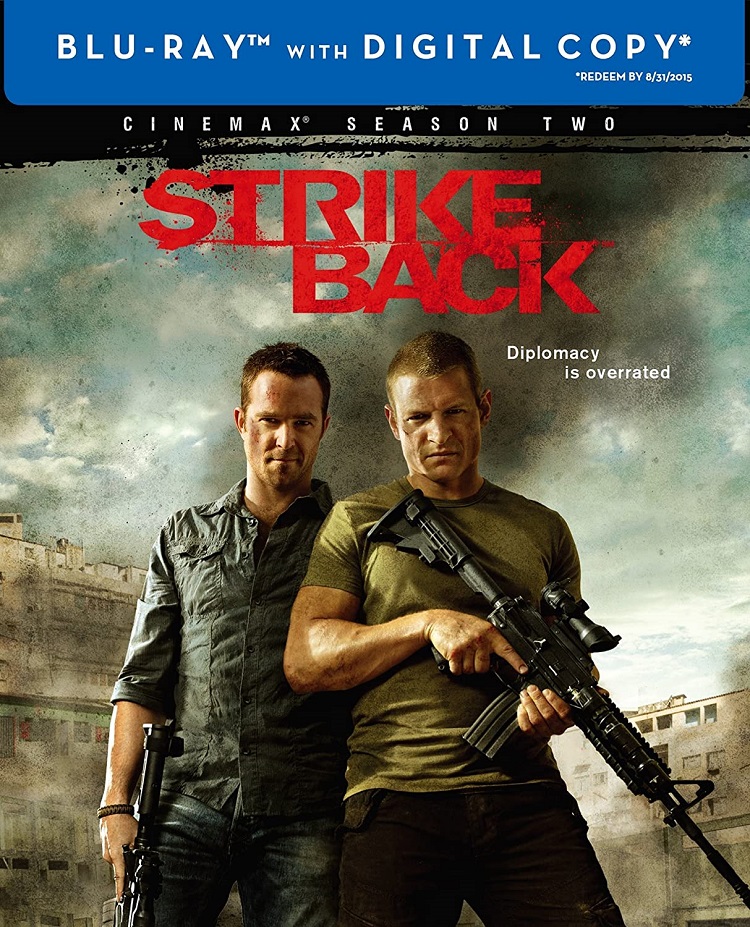
Throughout Strike Back‘s second season, a single episode did not go by where someone was not shot in the head at point blank range or had their throat slit. Similarly, if the show’s brash American ex-Delta force hero Damien Scott hasn’t bedded one of his female contacts, there’s certain to be a scene set in a strip club or by a swimming pool where some woman is swimming topless in order to fulfill the episode quota of nudity. Strike Back is ’80s action cinema made anew. Whether you find that damning, or high praise, will determine whether or not the show’s for you.
Originally a British series, in its second season Strike Back became a co-production with Cinemax (which means Strike Back: Cinemax Season Two is actually the third season of the show.) All the characters from the first series were dispatched, and two new heroes, SAS officer Michael Stonebridge and the aforementioned Damien Scott were introduced. They work for fictional ultra-secret agency Section 20, which has the most capable electronic surveillance systems in the world. Stonebridge and Scott are elite soldiers, almost without equal. Altogether, they go around the world shooting people and breaking things.
Characterization was where the first Cinemax season was most lacking: the main characters are more easily told apart by their accents than their actions, and the motivation of their comrades in arms were typically vague. The action was where the interest was, and it was mostly fine – shoot ’em up sequences with mostly (apparently) practical special effects and shot in such a way that it was actually possible to tell who was shooting at who – no shaky cam, no super-rapid editing.
This second Cinemax season ups the ante on every aspect. Both Stonebridge and Scott have higher personal stakes. Stonebridge has left Section 20 to become a trainer, so his wife doesn’t have to worry about whether or not their coming child was going to have a father. A soldier’s freak-out in a training session leading to loss of life starts Stonebridge on a path to personal tragedy, and back into the arms of Section 20.
The agency itself has new leadership in the shape of Rachel Dalton, a former MI6 agent whom no one in Section 20 thinks they can trust. Rachel proves herself a capable soldier – which leads to one of the problems the show has with its female characters. There are several female soldiers, both in Section 20 and in the ranks of the various militaries and mercenaries they run into. The problem is, they are almost uniformly boring.
It seems the producers think any vulnerability demonstrated by a female soldier would be overly “feminizing” and making them seem less fit for fighting. The solution: the women with guns in this show scowl and bark a lot, and don’t do much else. They don’t demonstrate the camaraderie and humor that marks Stonebridge and Scott’s bantering friendship. It’s as if constant scowling and humorlessness is what makes them tough. In fact, it makes them tend to be boring, one-note characters.
An exception to this is the Tuareg tribe leader our heroes encounter in the third and fourth episodes. Played by the striking Laetitia Eido, she has a sense of self, and a colorful enough background to be interesting. Every story in the series is a two-parter, which essentially makes five feature-length episodes. They take place in and around South Africa, where philanthropist billionaire Conrad Knox (played by Charles Dance, so you know he’s the villain before he opens his mouth) has big plans for the entire continent, and to pull them off he’s building an army, and in particular looking for a set of very powerful weapons that Section 20 want to keep out of his hands.
Strike Back plays at political relevance – the stories involve Libyan arms deals, Islamic terrorists, Zimbabwean revolutionaries, and other aspects of African political unrest. But there is no real, capital P, Politics in the show. Some of the typical latter-day soldier fatigue themes are evident (at least once per story, someone wonders if they like killing too much, or if they’re not just as bad as the bad guys, etc). However, a show which revels as much as this one does in people shooting each other, and blowing each other up, has no right to get on any moral high horse, and Strike Back, luckily, knows it.
Because it is the action that is the real star, and it is a lot of fun. There’s urban combat, car chases through the crowded slum areas outside Johannesburg, hand-to-hand combat, lots of grenade throwing, and just plain gunfights. In the last decade, while movie action has become more and more closely linked to comic books and CGI impossibilities, television has become a more welcome home for down to earth, and often more thrilling, violent action. Strike Back is a great example of this. The characters are rather simple, and their dialogue even more so.
Compared to similar early ’00s show The Unit, there isn’t anywhere near as much realistic army talk and jargon (though that show was co-executive produced and written by David Mamet). But it makes up for it with gorgeous visuals, interesting locales shot on location in South Africa, and lots of shooting, nudity, and soldiering. Strike Back is good clean sex and violence.
Notes on the Discs: Strike Back: Cinemax Season Two looks gorgeous on Blu-ray. It’s shot on 35mm, and has a striking cinematic presentation. The special features on the disc are limited to commentary tracks on a few selected episodes. The Blu-ray also comes with a code for a downloadable digital copy of the season.